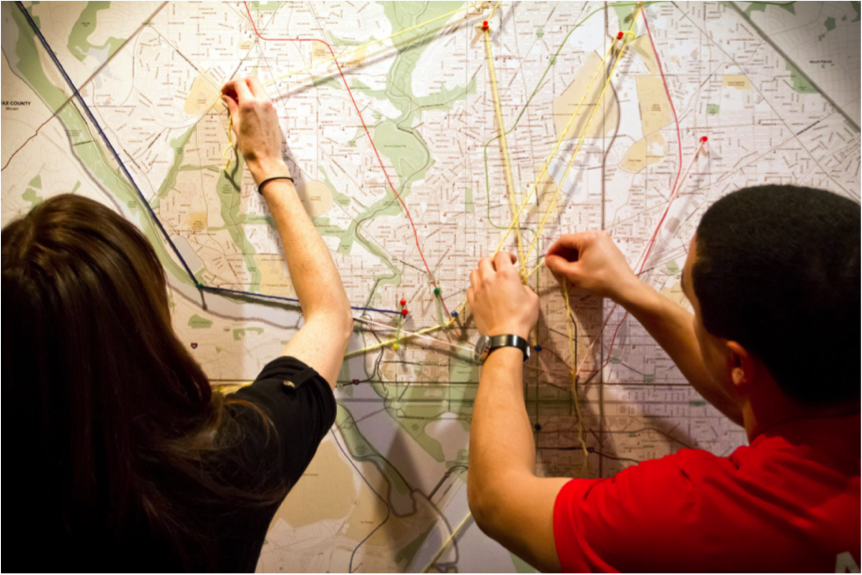
News
By Sean Doyle, November 25, 2019
 At issue were “the presence of bike lanes, the possible lengthening of commute times, and the possibility that traffic diverted…would fill neighboring streets.” But rather than propose a different design, pilot the new design to help win over skeptics, or do more outreach and education, officials just abandoned the plan altogether.
At issue were “the presence of bike lanes, the possible lengthening of commute times, and the possibility that traffic diverted…would fill neighboring streets.” But rather than propose a different design, pilot the new design to help win over skeptics, or do more outreach and education, officials just abandoned the plan altogether.
Choosing to do nothing is a choice in and of itself that often further marginalizes the people the changes are meant to empower or protect. We’ll never be able to build more livable, inclusive communities, save lives, reduce carbon pollution, and address any manner of other issues if we believe our communities must be preserved in amber as they are today.
“Yes” or “no” aren’t outcomes of public engagement
Community engagement is a crucial aspect of the planning process and it should be used to help design and then fine-tune interventions, not decide whether they should happen at all. If street redesigns are needed to enhance safety or access, or building more housing is essential to keeping up with demand or increasing affordable units available to a city’s least fortunate, “no” should not be an option. “No” often just elevates the voices of those who already have a home over those who need one; or those who think their convenience is more important than another’s safety.
Members of the public should be approached as local experts, but opportunities for input should be framed around shaping a project to best meet the community’s needs.
Just as in Pasadena, the City of Oakland planned to address speeding and other safety issues on a stretch of 90th Ave by turning the four-lane, two-way street into a two-lane, two-way street with a center turn lane and bike lanes on either side. However, in doing outreach in this lower-income community, the city found that the local bike culture revolves around the Scraper Bike Team, which teaches bike repair to local youth and hosts group bike rides “to help them stay active and avoid getting caught up in crime.” To accommodate this, the city augmented their plans; instead of curbside bike lanes, they added a two-way, protected bike lane in the center of the street and the Scraper Bike Team helped design the art that now covers the bikeway.
It’s essential to recognize that the question posed to the community was not if this redesign should happen to improve safety, but how.
Projects on a larger scale can also benefit from this kind of framing. In Washington, DC, outreach on the planned 11th Street Bridge Park has been going on for years. The park will be perched on the piers of the old 11th Street Bridge and span the Anacostia River, connecting the more affluent western bank neighborhoods of Capitol Hill and Navy Yard to the lower-income neighborhoods of Anacostia and Fairlawn on the east bank. From the beginning, planners were focused on housing affordability and the impacts such a large public investment would have on the area and it’s current residents. But through deep community outreach, they “quickly learned that safe and secure housing was so much more difficult without gainful employment so we added workforce development and small business enterprises” as focus areas, among other changes. The early outreach and engagement impacted the design of the park, the programming that will occur once it’s completed, and other public programs in surrounding neighborhoods to make sure this investment benefits the local community.
Planners don’t redesign roads, rezone neighborhoods, or propose other changes to city policy haphazardly—it’s very often part of a long-term plan that was already painstakingly crafted with public feedback over the course of months or even years. Long-term land-use and transportation plans build consensus around a holistic approach to improving safety, equity, access, or affordability, rather than making those decisions with isolated, piecemeal, case-by-case solutions. That’s why Minneapolis recently updated their zoning to allow duplexes and triplexes across the city, even in areas previously zoned exclusively for single-detached homes—the change was included in the city’s 2040 comprehensive plan.
Community builders have important jobs that can help us create healthier, safer, more inclusive cities and public engagement should be used to influence designs and the execution of projects. But it’s important that these professionals—and the city council members or mayor that will ultimately vote on an intervention—stay committed to forward progress.
Related News

© 2025 Smart Growth America. All rights reserved
Site By3Lane Marketing










